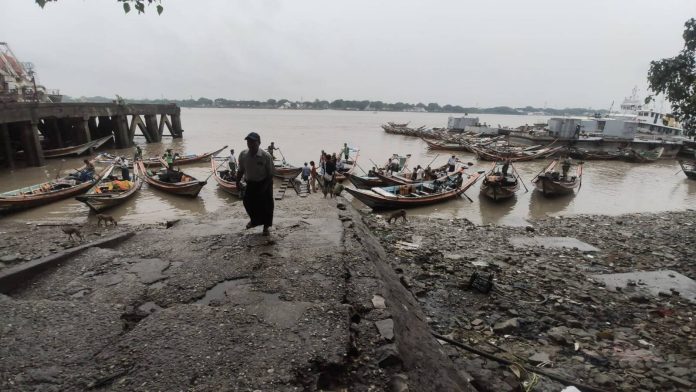Wai Yan Kyi Oo
For DVB
In the monsoon season, the skies open and unleash heavy rainfall on Yangon. Most days the sun is hidden behind the clouds. *Myint is a skipper who provides daily public transportation for commuters across the Yangon River from rural Dala to urban Botahtaung, located on the eastern edge of downtown Yangon. Nearly 180 boats criss-cross the river every day between Dala’s Kamakasilk and Seik Kyi Kanaung to Yangon’s Nan Thida, Sint Oh Dan, and Botahtaung jetties.
Myint’s small motorized wooden boat docks at Botahtaung jetty, waiting for passengers to take back to Dala. But during the rainy season, most prefer the bigger, double decker, ferry boats to protect them from the rain. The rain can become too much of a hindrance for skippers operating smaller boats. Before each departure, Myint takes a look out at Yangon River to assess whether or not he can make it before the rain arrives. Each trip back and forth takes only five minutes. Today, Myaint takes a look across the river and can barely see Dala on the other side. “The rain ruined [my day] again,” he said.
The monsoon’s arrival isn’t the only reason for Myint to lose money, or a day’s work. Rising fuel prices have also affected his daily income. He goes to work from 4 a.m. to 8 p.m. every day ferrying passengers to the city and back. The cost of a one-way ticket has gone from K100 to K300. Many passengers complain before paying their fare. Inland Water Transport provides ferry boats. The cost remains K200 for a one-way trip. But some passengers want the convenience of the smaller motorized boats, like the one Myint operates. “The ferry leaves at 5:30 a.m. and it does not work for us. So, we usually take small boats in the early mornings and in the evening too, during rush hour, as too many people take the ferry at this time,” said an unnamed Dala Township resident working as a vendor in Yangon.
“During the COVID-19 pandemic, fuel prices were really low. But now, a bottle of fuel costs over K2,000 and it doesn’t even cover the cost even if we have enough passengers,” said Myint. A bottle of fuel used to last for up to three round trips. “If we’re loading passengers from the Yangon side, as specified, I can fit up to eight people and earn K2,400 per trip. Sometimes, passengers pay the fee even though there are not eight people. We have to find that amount for a trip in order to cover the fuel cost,” said another skipper at Bohtataung jetty.
“If the weather is nice, business is good. But if there aren’t any customers at all it will become a tough day for us. As food prices are high, it’s very difficult to earn enough to provide for our families. We earn up to K10,000 per day. But I think our life will be more difficult when the Dala Bridge project is completed,” said Myint. The Yangon-Dala bridge will connect Yangon’s Sint Oh Dan to Dala’s Kamakasilk jetty. The bridge is 1,686 meters long with a width of 26.5 meters. The regime’s Ministry of Construction estimates it will be completed by this December.
*not his real name



